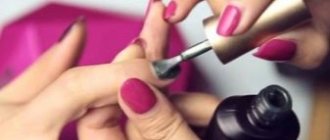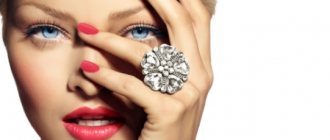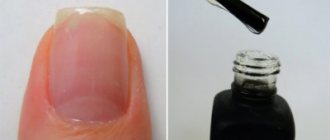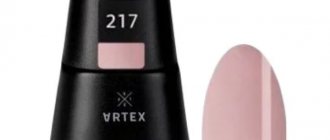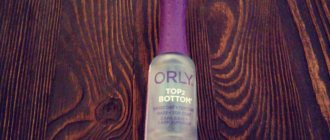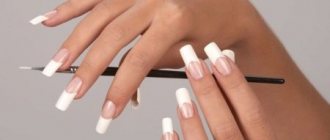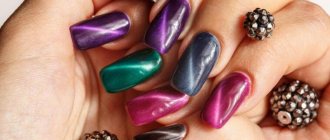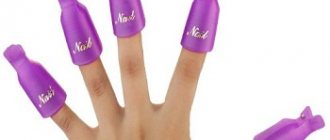To create a perfectly smooth surface of the nail plate, a special product is used - a gel polish base. With its help, you can create a magnificent manicure that will look perfect on your nails and maintain its durability for as long as possible. However, in order for the base to last a long time, and for detachments, cracks and chips to not appear on the surface of the manicure, it is very important to choose the right product and accurately determine the best material. These are the products that can be found on the website https://staleks.ua/brand/komilfo.
What is camouflage nail base?
The composition serves as a base layer for applying the finishing coat. Camouflage comes in different consistencies and shade palettes. Pastel colors are often used because they best match the natural color of human skin. Thanks to this, the modeled nail plate looks as naturalistic as possible.
Natural tones:
- universal;
- always relevant;
- fit perfectly into any dress code;
- fit well with various outfits.
This is the best option for girls with thin and flaky nails. With its structure and density, the camouflage cosmetic composition resembles a natural nail plate. This manicure looks as naturalistic as possible.
The camouflage is polymerized under the influence of an ultraviolet lamp or LED radiation. The nail extension procedure does not take much time and does not require special skills.
The naturalness of a nude manicure based on a camouflage base allows you to successfully combine it with fashionable wardrobe items and accessories, and the variety of body colors allows you to choose a shade to match the color of the skin of your hands and face.
The composition forms a thin and durable polymer film with increased adhesive properties on the nail plate. It is great for doing your own extensions and creating a flawless manicure at home.
The viscous material makes the nail plate absolutely smooth. It provides air access to tissues, preventing the development of fungal microflora and the occurrence of an inflammatory process in the most sensitive area of women's hands.
What is camouflage used for?
Nude manicure based on rubber, acrylic or silicone is used to lengthen and strengthen the nail plate, disguise aesthetic flaws and anatomical defects. In a three-stage system, camouflage serves as the foundation on which the gel polish rests. Therefore, increased demands are placed on its strength and reliability.
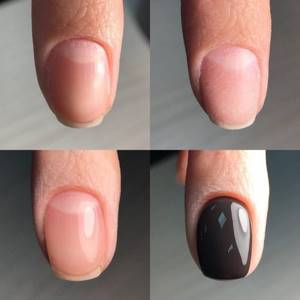
The camouflage base (what kind of polymer it is is a separate question of choosing a product) can be acrylic, silicone or rubber. It can be made nude, pastel or transparent. The last option is used when creating an artistic French manicure - a French manicure.
The main purposes of camouflage:
- nail plate modeling;
- improvement of its anatomical structure;
- correction and masking of various defects;
- creating a durable base for applying gel polish;
- increasing the durability of manicure;
- protection of fabrics from the harmful effects of chemically aggressive coloring pigments;
An important function of the polymer foundation is to level the surface to distribute the finishing layer.
Camouflage gives destructive nail plates with microcracks, tubercles, and other aesthetic defects a uniform texture. On such a surface, the manicure retains its original appearance longer than usual. In addition, the base thickens the nail plate and makes it stronger.
Often nude camouflage is used for gel polish coating with:
- shimmer;
- sparkles;
- silver plating;
- original mirror or futuristic titanium effect.
The polymer base performs a healing function, resuscitating and restoring the natural structure of the nail plate after removing a chemically aggressive colored manicure. Its formula has a beneficial effect on the surrounding skin.
Modeling on paper forms: step-by-step diagram
Step-by-step scheme for performing modeling with camouflage gel on paper forms:
- By analogy with the previously described technology, it is necessary to disinfect hands, manicure, and prepare the nail plate. Then apply a thin layer of base using rubbing movements and dry in a lamp.
- Before installing the paper form, it must be trimmed in the area of the smile and side ridges to repeat the anatomical shape of the nail. Thanks to this, the form will fit snugly to the free edge. The recesses in the area of the side bolsters will allow you to form a correct transverse arch.
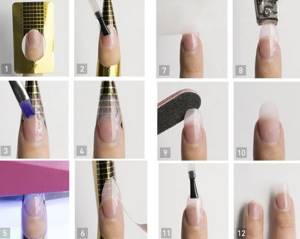
- The form must be glued, placed under the free edge, observing the central axis, and the adhesive base pressed against the finger. Particular attention must be paid to the end. The form should stand clearly under the nail, without touching the hyponychia. Otherwise, a step will form.
- A small amount of gel is applied to the form to form a thin base for the future nail. The material is distributed over its surface, connecting the free edge with the natural nail. It is important to thoroughly work out the growth points and side walls. The markings applied to the forms are a hint and guide for the master. The result must be dried a full cycle.
- After polymerization, the substrate is coated with a layer of gel to moisturize and improve the distribution of the material. A small drop is placed on the brush and placed in the center of the nail bed. Slightly recessing the brush into the material, move it towards the cuticle, after which, with a superficial touch, the remainder of the gel is brought to the free edge. The thickness of the material at the end should not exceed the thickness of a credit card. The result must be dried a full cycle.
- After modeling all ten fingers, the sticky layer is removed from the surface of the gel and the architecture is finalized with a file (if necessary), giving clarity to the selected shape.
- The dust remaining as a result of sawdust is brushed off with a stiff brush and the nails are thoroughly wiped with a lint-free cloth soaked in a degreaser.
- Glitter is applied to the surface using the chosen technique or another design and polymerized in a lamp.
- A finishing coating is applied to prolong the wearability of the design, polymerized and removed if necessary.
To apply camouflage gel, you need to choose a brush that is convenient in shape and size. Nail technicians do not recommend using brushes that are too wide and fluffy. It is more convenient to use a flat, rounded or square brush, the size of which does not exceed ½ the width of the nail plate.
Application Features
To create a flawless manicure based on camouflage, a special coating technology is used. Gel polish applied in this way lasts a long time, without chipping, peeling, or scratching. In salons, masters pre-prepare the nail plate for the procedure.
The camouflage base (what it is and the sequence of actions for application are described in the instructions that come with the manicure composition) is applied only to a cleaned and degreased surface. Professional training is carried out using a special apparatus.
With its help, they eliminate impurities, remove the cuticle, and remove dead fragments of the epidermis surrounding the nail plate. At home, you can use the accessories of a manicure set - tongs, a regular nail file, and a sanding buffer.

A primer is applied to the treated surface. When decorating the nail plate with a camouflage polymer, you can use a composition of a dark shade to create. expressive boundary between the bed and the edge contours.
In the fashion trends of French manicure, a polymer base of a three-layer design is used in conjunction with gel polish of a delicate milky shade. In case of severe destruction of the nail plate, it is advisable to use camouflage of the most dense consistency with a high viscosity index.
Shades
A huge advantage of camouflage gel is its fairly wide variety of color palettes. Thanks to this, professional craftsmen can easily select the appropriate shade for each client. This cosmetic product helps you create a French manicure in a short period of time without much effort. The shades that are presented on store shelves are ivory, various versions of pink, peach, light and dark beige.
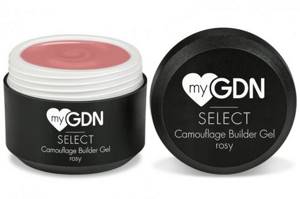
Thanks to a fairly large selection, the final result is as natural as possible and is absolutely no different from a natural nail. This makes camouflage gel even more popular among manicurists.
Types of Camouflage Gel
There are 3 phases of the masking polymer base. Each type has its own purpose and is used for different types of nail plates. You need to select the base individually, depending on the desired effect.
The phases are different:
- consistency;
- chemical properties;
- physical and mechanical characteristics;
- provided by the application technology.
All of them perform a leveling function and ensure reliable adhesion of the gel polish to the surface of the nail plate.
1-phase

This is the most commonly used and easiest to apply polymer manicure base.
This composition is usually transparent in color, of medium thickness and viscosity, and does not bubble.
It polymerizes quickly when exposed to ultraviolet radiation.
Once completely dry, it can be easily given the desired shape by filing or polishing.
A 1-phase type camouflage base ensures reliable adhesion of the nail plate to subsequent layers.
What does it give:
- manicure lasts a long time;
- is highly resistant to external factors;
- has an impeccably aesthetic appearance;
- Easy to apply gel polish with shimmer, glitter, silver effect.
This acrylic or silicone base can be used to create a uniform matte or glossy finish and form any image.
2-phase
This type of camouflage base has a thinner consistency, making it a little easier to work with. It is used for nail extensions while simultaneously strengthening them. 2-phase camouflage is applied to an architectural base coat to give the manicure the most natural look. This base is applied in 3 layers.
Each of them has its own functional purpose:
- 1st – ensures reliable adhesion of the gel polish to the nail surface;
- 2nd – corrects anatomical errors of the plate;
- 3rd – consolidates the leveling effect.
This polymer is not very popular because it does not give as durable a result as the previous option.
3-phase
These camouflage bases are the most liquid. The composition quickly spreads over the surface of the nail. The 3-phase base is applied in an extremely thin layer. To thicken the nail plate, successive repeated applications are required after the lower tier has dried.
Due to its liquid consistency, this composition is prone to the formation of bubbles. To avoid this undesirable effect, the polymer is distributed over the surface of the nail slowly, carefully, thoroughly.
Creating a manicure based on a 3-phase camouflage base takes a lot of time. But the result is excellent. This coating is not afraid of mechanical stress.
Common Mistakes
Sometimes, instead of a base, beginners apply a top coat or color right away, but this is a huge mistake. Knowing what a base for gel polish is, you will be able to avoid mistakes. If you immediately apply topcoat to your nails, the coating will come off within 3-4 days. With colored varnish, everything is much worse - the pigment will eat into the nail plate. Over time, you can understand how much product needs to be applied and how long to dry it.
Applying an excessively thick layer will lead to a negative effect - your nails will resemble a layer cake due to the thickness. However, a layer that is too thin will not hide all imperfections and will not work as intended. A long, unstrengthened plate risks breaking at a stress point. Thick materials are great for building up and adding strength; liquid nail base is just a protective layer.
Often the base smells unpleasant, and when polymerized in a lamp it causes a strong burning sensation. He says something similar about the low quality of the product; it is undesirable to use it. Cheap products often provoke allergies due to their high acid content; more expensive substances undergo strict control. A negative reaction of the body is not excluded, but the risk is minimized.
What a base is for, how to apply it and avoid mistakes - a beginner needs to know all this before starting a manicure with gel polishes. Incorrectly selected products often lead to negative results. The products vary in composition and consistency, but they have the same general purpose.
Advantages and disadvantages
The camouflage base gives the nail plate anatomical perfection, high strength, and absolute smoothness. The list of advantages of the polymer base is not limited to this.
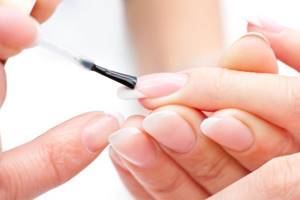
Some of the important advantages of such a multi-layer manicure include:
- strengthening weakened and damaged nails;
- the content of special biologically active components that prevent fungal infection and the development of the inflammatory process;
- a unique polymer coating formula that ensures free penetration of the atmospheric mixture into fabrics;
- long service life of the cosmetic coating;
- natural look;
The camouflage base (what it is and what its features are described in the article) does not allow the multilayer coating to delaminate. It is ideal for fans of fashionable French manicure - French. Polymer material is not without a number of disadvantages.
The most significant of them:
- the high price of a camouflage base, extension procedures and aesthetic correction of nail plates;
- the need to re-manicure monthly;
- some components of such compositions can cause allergic reactions;
- If the application technology is not followed, you can damage your nails;
Improper use of a UV lamp results in microscopic burns to the skin. One of the disadvantages of this manicure is the duration of the nail extension process.
Conclusion
Which base is best for nails is determined by the master himself. The choice is focused on the condition of the girl’s nails. Trainee masters develop an individual style in their work over time. Even the speed of operations is different for each of them.
However, there are general rules that will improve the quality of alignment:
- The more liquid the consistency of the composition, the less quantity is required.
- There should be quite a lot of thick base, and it takes time to distribute it evenly (spreading).
- You can't overdo it with primer. Otherwise, a glass effect will form and the base will drain.
- When distributing a drop, the brush does not touch the plate! She remains “in the air.” That is, it is immersed in a drop without allowing it to come into contact with the surface. This requires a fair amount of skill and dexterity.
- After polymerization, the base can be adjusted. For this you need the softest buff. Literally a few movements will be enough to smooth out the defect.
- During the procedure, it is necessary to adhere to the established algorithm and follow the sequence of application of layers. You can improvise when choosing decor and color. But the main manipulations are performed technically - according to the rules.
- The first layer is considered a primer. The second, when distributed over the surface, disappears at the side rollers. The base is not applied under the cuticle.
- Colorless compounds polymerize very quickly. In the absence of pigment, the rays will take less time to penetrate the structure of the material.
- If the lamp burns, then pull out your hand with the material facing up. This will prevent the material from spreading. To relieve pain, the fingertips should be pressed against the table for a few seconds. Sometimes reducing the heating power is enough.
The most common cause of delamination is illiterate selection of the base without taking into account the individual characteristics of the plate. This is followed by thinning due to harsh removal of the coating. Seeing the unsatisfactory condition of the nails, a good master will conduct a consultation and advise the girl to take a time out. She will appreciate your participation and will definitely return to you in the future.
Camouflage base color
The modern beauty industry is trying to reach the widest possible range of consumer audiences. Therefore, manufacturers produce camouflage compositions for any color type of appearance and skin tone.
The following colors are ideal for dark-skinned girls:
- beige;
- apricot;
- peach;
- nude;
- pale pink.
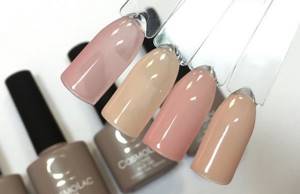
They create the most expressive color contrast. For those with fair skin, it makes sense to give preference to a translucent composition, ivory or tea rose.
By varying the thickness and saturation of the polymer coating available, you can create unique colors of the camouflage base for gel polish with shimmer, shiny inclusions, and a silver effect.
The manicure base in the rare shade of Ivory Idy, a delicate creamy color, looks very expressive on sultry brunettes.
The most unusual colors of commercially produced nude camouflages:
- "languid kiss";
- "almond roast";
- “cream praline”;
- "bold peach"
All of them belong to the palette of flesh tones and represent a darkened or lightened variation of the classic beige color of different viscosity and color saturation.
Warm colors (peach, apricot and others) emphasize the graceful glow of a bronze tan or dark skin. Such camouflage bases are relevant for the summer period. A modern classic of the genre is considered a transparent polymer in combination with a French manicure.
A splash of snow-white pigment will add a touch of frosty mood to any girl’s summer look. For silver gel polish, it is advisable to choose a nude base that is close to a yellow-beige color. For a manicure with glitter, a nude camouflage base is perfect, as close as possible to the natural skin tone.
Familiar varnishes
Many beauties today can afford to buy a variety of colors of simple varnishes from Jean Ashley, Golden Rose and many others.
Incredibly beautiful shades of deep dark cherry, with a wine tint or blue with silver splashes of small sparkles. Black, white, green, blue. With the help of a whole rainbow of colors and the finest brushes, patient craftswomen create magnificent miniature pictures that adorn well-groomed hands. On the nails you can see small polka dots, stripes, elegant openwork patterns, curls, flowers, hieroglyphs, tints and shimmers.
It takes a lot of time to complete complex, amazingly beautiful drawings. If you lose two hours on this painstaking work and literally the next day you discover chips in the coating, of course it will be very disappointing. Those who have a large family have a lot of housework every day: they have to do laundry, clean, wash floors and dishes. Of course, you can wear rubber gloves. But not every job can be done in them. For example, knead dough for buns, bathe a child, preferably without gloves.
When the famous shellacs appeared, women's nails became much more beautiful. True, usually those with long claws are spoiled lazy people who have servants, governesses and no worries. God bless them. But what about simple girls who need to change their baby’s clothes and want beauty? Nails can be made with oval, safe length, tips and with a beautiful pattern. Therefore, young mothers began to have thoughts about how to make a beautiful manicure more durable.
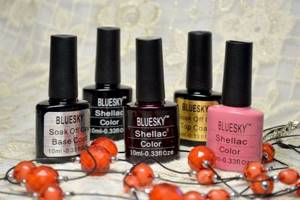
How to make the right choice?
You need to focus not only on the color of the base, but also on other criteria. One of the most important is the type of polymer composition. Rubber-based products are intended for aesthetic correction and modeling of the natural anatomical structure of the nail plate.
This wood resin lays down in an even layer, increases the thickness of the surface, and gives the composition thickness and ductility. Rubber bases are great for smoothing out problem nails. They are recommended for owners of thin and fragile plates. This polymer prevents the formation of microcracks.
A camouflage base (what it is and why it is needed is described in the article) is selected depending on the desired effect and the condition of the nail plates. Manicure compositions based on acrylic powder are popular.
It polymerizes under the influence of ultraviolet radiation and forms a thin but very durable film. Then another layer is applied, thoroughly polished, and only then gel polish with shimmer, glitter, silver or another effect is applied.
The tandem of an acrylic camouflage base with a finishing coat forms a durable nail frame. It prevents the plate from delaminating and ensures the durability of the manicure. Its only significant drawback is the difficulty of removal.

A silicone base is also often used. It is produced both in a gel-like state and in the form of stickers. The first option is chosen for flawless leveling of the damaged nail plate. Gel-like silicone has good sealing properties and a viscous consistency.
Stickers are suitable for those who want to restore the natural shape of their nails or lengthen them. This base does not require polymerization and can be easily removed. The most breathable coating is created by a water-based liquid camouflage base. Its main disadvantage is the fragility of the manicure.
How to use camouflage nail base?
This procedure is carried out mainly in beauty salons. If you follow the technology of applying a camouflage base and gel polish, you can create a flawless manicure at home.
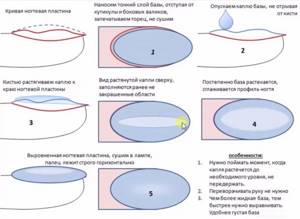
The figure shows the rules for using a camouflage base to straighten nails.
Step-by-step instruction:
- First, prepare the nail plates by cleaning and degreasing them.
- Perform a standard hygienic manicure, removing dust with a soft buff.
- The nails are given the desired shape by filing.
- Then the extension form is applied so that its center coincides with the middle of the native nail plate.
- The template is securely fastened.
- Next, use a brush to grab a small amount of camouflage polymer and distribute it in a thin layer evenly over the entire surface to be treated.
- Polymerize under a UV lamp for 2 minutes.
- Remove the dispersion coating and use a manicure file to give the nail plate streamlined contours.
If the camouflage base is applied in several layers, each of them polymerizes for 2 minutes. after the previous one has completely dried. Upon completion of the process, the template is removed and a fixing gel polish is applied.
Terms of use
Before applying the base liquid, a manicure is done: the cuticle is removed, the nail plate is shaped, and degreased. You should apply Kodi base or a product from another manufacturer carefully to avoid streaking. A small amount of material is collected onto the brush so that it does not flow, but this is enough to paint one plate.
The base should not flow under the skin. The drop should be placed approximately in the middle, brought to the cuticle, without lifting it from the nail. Then move to the side rollers, reaching the edge. Often, a thin brush is used to paint the area near the skin. The last step is to seal the edge. If the surface is lumpy or rough, then one thin layer is not enough. The second time you can act more boldly, distributing the material from the top to the tips. Movements should be light; the brush should not be completely placed on the plate.

Experienced craftsmen have a little trick, after which the base for gel polish evens itself out. After application, it is recommended to turn your palm over with your nails facing down, wait a few seconds and place it in the lamp. Dry the product for 20-30 seconds in an LED lamp and 2-3 minutes in a UF lamp.
Review of camouflage nail bases
Polymer compositions from all manufacturers have virtually identical chemical formulas, with the exception of the coloring pigment used. When choosing, you need to make sure that there is no allergic reaction to it.
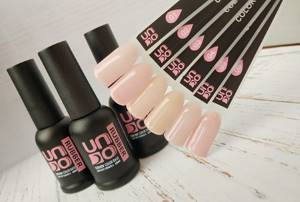
List of popular camouflage bases for gel polish with shimmer, sparkles, silver:
| Name | Product Description | Volume | Price |
| CND Base Coat | The composition has a dense consistency. Polymerizes in 30 seconds. Compatible with any gel polish coatings. Ideally aligns the nail plate. Often used for gel polishes with shimmer. | 12.5 ml | 1830 rub. |
| Uno, Color Rubber Base | Rubber-based composition. Thanks to its dense texture and increased viscosity, it has good leveling properties. Color – beige with a delicate pink undertone. | 8 ml | 490 rub. |
| Cosmolac Cover Base 01 | Medium consistency camouflage base. Used for leveling, toning, strengthening the nail plate. Polymerization time – 3 min. | 7.5 ml | 240 rub. |
| Kodi Rubber Base | Rubber polymer of viscous consistency. Color – nude. Suitable for any varnish gels. | 7 ml | 450 rub. |
| Klio Professional | Composition of a neutral beige shade on a rubber base. Used to smooth out lumpy nail plates. Has a strengthening effect. Polymerizes under ultraviolet light - 2 minutes, under an LED lamp - 1 minute. | 12 ml | 470 rub. |
| Haruyama Base | Medium thickness camouflage base with a neutral flesh tone. It is well distributed in an even layer over the nail plate. It is popular due to its low price. It is incompatible with colored Chinese gel polishes. | 30 ml | 600 rub. |
| Beautix Royal | Rubber polymer with self-leveling properties. Provides reliable protection against mechanical damage to fragile nails. The universal nude shade allows you to combine it with any gel polishes - shimmer, glitter, silver. | 15 ml | 990 rub. |
The products of the American brand CND are in especially high demand. Such compositions have an optimal consistency. Applying such a polymer composition at home is not difficult.
Acidity
The golden mean of base acidity is pH=6. Since the nail is porous, all elements applied to it end up in the growth zone. Exceeding this parameter of the product used can result in a chemical burn.
Moreover, the consequences become noticeable not immediately, but as they accumulate. Over time, the nail splits, becomes thinner, or becomes loose. The gel practically stops sticking. Often these phenomena are mistakenly considered an allergy. But in reality it is the effects of acids.
In order not to lose clientele due to illiterate selection of products, it is recommended to check the acidity of the products used in advance.
To do this you need to follow the steps:
- wet the indicator strip;
- Apply a drop of the test product to the wet end;
- visually compare the color of the strip and the tone on the reference scale.
The conclusion about the safety of the acidity level of the nail base will be obvious.
But even by choosing the right product and setting the pH, you can cause a burn. After all, this parameter is very flexible. It may change as it dries and hardens. The entry of the composition into chemical reactions with other agents also plays a role.
To avoid unpleasant consequences, it is recommended to use an acid-free primer. It will work on the principle of “double-sided tape”, providing a strong adhesion with delicate impact.
With the base, the operation is performed as follows: the first layer is applied with rubbing movements and dried for half a minute. Then a little product is dripped into the center of the plate and distributed as carefully as possible, without touching the skin of the finger.
How to make a camouflage base with your own hands?
It’s not difficult to make such a manicure product yourself. There is liquid silicone on sale that is quite suitable for this purpose. You can use gel rubber or acrylic powder. This substance is mixed in a small container with regular nail polish of the desired shade.
The result will be a universal camouflage base. Add 2-3 drops of nail polish to 20 ml of polymer substance. You can use a ready-made transparent base, dilute it to the desired consistency and add a coloring pigment of the desired shade. This will give you the opportunity to get a unique color scheme and exclusive texture.
